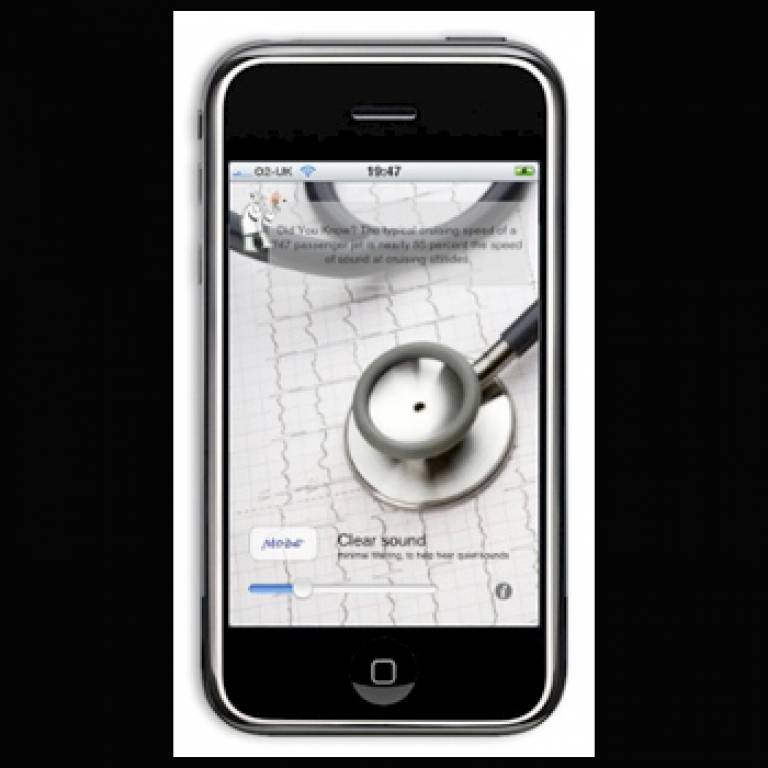Q&A: UCL computer scientist hails runaway success of iphone stethoscope
24 September 2009
Links:
 cs.ucl.ac.uk/" target="_self">UCL Computer Science
cs.ucl.ac.uk/" target="_self">UCL Computer Science
Dr Peter Bentley readily admits he developed a piece of software that turned an iphone into a stethoscope as a bit of 'fun'.
But the experiment that began in UCL Computer Science has become a runaway success by any measure.
iStethoscope has been downloaded millions of times since Dr Bentley submitted it to Apple's iTunes App Store.
Now cardiologists and other medical professionals around the world are using a new version of iStethoscope as part of their clinical practice.
What is iStethoscope?
'iStethoscope' turns your iphone into a stethoscope. It's an audio amplifier which takes sound from the built-in microphone, amplifies and filters it in real time, and plays it to the user. If you shake the phone or touch the stethoscope image, it then plays back the last eight seconds, together with a spectrum analysis of the audio.
You can also email the audio and spectrum analysis to anyone you like. The program allows you to modify the filter settings to suit you. It also has an accelerometer mode, where the iphone's accelerometers are used to transform tiny movements into audio.
How did you come up with the idea?
The idea began as an experiment last year. I had a new popular science book out (The Undercover Scientist) and I wanted to see if I could tell people about the book using a free iphone application that did something useful. Being a computer scientist I could have written almost any kind of program, but I decided that it might be fun to have a stethoscope in a phone.
What sort of technical challenges were involved and how long did it take to develop?
The hardest part of the program was to record and play audio simultaneously, while amplifying, filtering, and saving the audio for the spectrum analysis at the same time. I also needed to figure out what kind of filtering was useful. It took a few weeks of experimentation to get right.
How successful has it been?
I began with a free application because it was simply intended as a fun toy. To my astonishment, this was downloaded by several million people all across the world over a period of six months. Sometimes I received negative feedback from users - it turns out that it requires training to know where to listen to your heart.
But I was amazed when I started receiving emails, phone calls and visits from cardiologists, from all over the world. They were all tremendously excited. Apparently the combination of the excellent hardware of the device with my little program turns the iphone into a digital stethoscope that works better than most other commercially available digital stethoscopes.
In the words of Glenn Nordehn, a cardiologist researcher and specialist on digital stethoscopes at the University of Minnesota: "iStethoscope Pro is something I have expressed a lot of enthusiasm about to you. I know it is truly the best thing to come around in terms of medical equipment in a very long time for many reasons. And your closest competitor charges about 3,000 times what you do. Stethoscope and heart sound research is my life in many ways - and, without sounding arrogant, I know this
business and research."
So with this kind of encouragement I developed 'iStethoscope Pro' - the version available today that is packed full of the features requested by all these cardiologists. It is now actively being used in clinics (one medical student told me how he stretches a new surgical glove over the bottom of the phone before recording the heart audio for each of his patients).
I'm now collaborating with Glenn Nordehn - there is a 'medical trial' option in the program which allows you to email your heart audio direct to Glenn, who is collating a database of heart sounds from my app which will be used to train an automatic diagnosis system. I'm receiving various add-on stethoscope devices and microphones in the post from people who want me to provide filter settings for their equipment.
I've now created a second application called iAuscultate with Glenn, which trains users how to listen to heart sounds and understand spectrograms in order to diagnosis heart conditions. I've also begun discussions with other cardiologists about developing new applications such as ECG readers.
How great is the potential of such devices?
I think there is huge potential. These devices are made in such volume and sold in such a competitive environment that their hardware is cutting-edge technology - much more powerful and much cheaper than you see in traditional medical equipment.
I think we are reaching the stage where we will have pocket-sized universal computing gadgets that can have off-the-shelf connections for stethoscopes, blood pressure cuffs, etc, in addition to behaving like phones, GPS gadgets, games machines, internet browsers.
I also think there is huge potential for using applications for these devices to reach millions of people. It would not surprise me if we started seeing academic journals, magazines and mainstream books all distributed in this way in the future.
What are your future plans?
Even though I'm a computer scientist, I'm still taken by surprise at the popularity of some innovations. I guess I'm going to keep trying new ideas and see what happens next!
Image: iStethoscope graphic
Related stories:
UCL researchers develop groundbreaking iPhone application
Head of UCL Computer Science wins medal
 Close
Close

